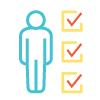
Exploring Bias and Learning Culturally Responsive Practices
People with disabilities are protected against discrimination in employment, transportation, public accommodations, communications, and access to state and local government’ programs and services by the 1990 Americans with Disabilities Act (ADA).
However, bias against people with disabilities is still pervasive:
- People with disabilities remain significantly less likely to be employed than people without a disability
- Over a third of people tend to think people with disabilities are not as productive as everyone else
- Unconscious and conscious bias against people with disabilities appears to be higher than any other social group
When combined with biases against additional differences (e.g., culture, race, gender, sexual orientation, etc.) a person with a disability can feel overwhelmed and defeated before they start.

Examining Your Biases
Everyone has biases; they are the scopes with which we learn to look at the world. Bias against those who are different is often implicit, meaning it is not a conscious thought process. As a service provider to diverse people with disabilities, you are in a unique position to provide support and services that demonstrate awareness and respect for each person’s unique being and circumstances.
To do that, it’s necessary to be aware of your personal biases and how they influence your decision making when working with people with disabilities.
Following are some tools and resources to get you started:
Harvard’s Implicit Association Test
This tool measures attitudes and beliefs people may be unaware of or unwilling to report. It provides an assessment of biases against disability, race, gender, age, sexuality, and other social groups.
Digging Deeper Into Unconscious Bias
How does bias affect your decision-making process? Use this resource to take a look at common biases and reflect on how they appear in your practice as you work with diverse people with disabilities.

Learning Culturally Responsive Practices
Culturally responsive practices are provided in a way that reflect a deep and nuanced understanding of cultural experiences, preferences, and differences. These practices include:
Awareness of your limited understanding of cultures different than your own
Skills for promoting leadership from those of other cultures
Recognition that you can't substitute for those who are experts in their own culture
Source: Kivel, 2007 (PDF)
As you learn to use culturally responsive practices, here are some ways you can work toward increasing employer support for hiring diverse employees with disabilities and providing them with support:
Interview people with disabilities within an organization to understand their perspective on workplace culture and acceptance
Encourage employers to implement disability awareness and sensitivity training for all members of their organization
Promote a more inclusive workplace by encouraging employees without disabilities to acknowledge and confront their own biases
Source: Wright et.al., 2020
Tools
Continue to Explore Bias and Culturally Responsive Practices
Learning to provide services that are culturally responsive is an on-going process. It requires challenging personal biases and embracing different ways of approaching and overcoming obstacles.
Use these resources to continue exploring, learning, and providing services that demonstrate awareness and respect for each person’s unique being and circumstances.
- Examining Biases to Support Employment as a Means Out of Poverty
- Equity: Wisconsin’s Model to Inform Culturally Responsive Practices PDF
- Racial Equity Tools
- Black Lives Matter: Anti-Racism Resources for Social Workers and Therapists
- Implicit Biases and People with Disabilities
- Understanding Employer Views on Disability and Hiring Practices

